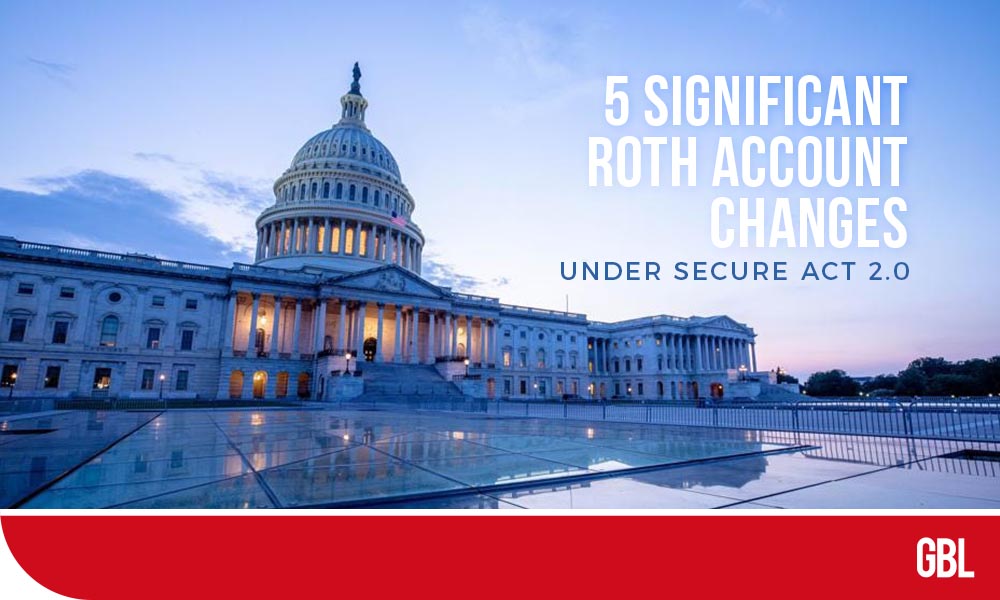The Secure Act 2.0, signed into law on 29th December 2022, introduced significant changes to tax law. The most significant changes include a move towards “Rothification” through expanded use, new requirements, and the ability to transfer money from college savings accounts to Roth IRAs.
What is SECURE Act 2.0?
SECURE Act 2.0 was signed into law by President Joseph R. Biden on 29th December 2022 as part of the Consolidated Appropriations Act (CAA) of 2023. It aims to improve retirement savings options in the US, including 401(k)s and 403(b)s. It builds on the Setting Every Community Up for Retirement Enhancement (SECURE) Act of 2019.
Top Five Significant Roth Account Changes
Below are the top five Roth account-related changes to retirement law following the passing of the Secure Act 2.0.
1. Catch-up Contributions For Higher Earners Must Go Into Roth
Another significant change in Secure Act 2.0 is the requirement that plan participants with 50+ age make catch-up contributions to a Roth account.
If you are 50 years old or higher and earned $145,000 or more in the previous calendar year, any catch-up contributions you make to an employer-sponsored retirement plan must be deposited into a Roth account.
If you earned less than this amount, you could deposit your catch-up contributions into either a Roth or traditional (pre-tax) account, such as a 401(k). Pre-tax or Roth contributions are currently allowed. The changes will be applicable to 401(k), 401(a), 403(b), and 457(b) plans from 2024.
The income threshold may be adjusted for inflation in the future. The purpose of this rule is to limit the amount of money that can be saved in tax-deductible retirement accounts, but it also means that more money will be saved in a Roth account, which is tax-free at retirement.
Impact on Retirement Savers
The government wants to limit the amount of money that can be saved in tax-deductible retirement accounts to encourage more money to be placed in after-tax Roth accounts, which offer tax-free withdrawals during retirement.
2. 529 Plan Ro Roth IRA Rollovers
The Secure Act 2.0 enables penalty-free rollovers from 529 college savings plans to Roth IRAs with certain limitations to help alleviate fears of parents regarding over-funding 529 college savings accounts.
The lifetime rollover limit is $35,000, and the annual rollover limit is based on the yearly IRA contribution limit, including contributions made to an IRA. The total of the rollover amount and annual IRA contributions cannot surpass the earned income of the designated beneficiary for that year.
The individual must be the designated beneficiary of the 529 plan and move the funds to a Roth IRA in their name. The 529 accounts must have been opened for at least 15 years, and contributions, as well as earnings made within the last five years, are not eligible for rollover.
The amount rolled over is tax-free and penalty-free. It is one of the significant changes in the Secure Act 2.0. and is an entirely new rule with potential planning opportunities, but further guidance from the IRS is needed. The ability to do these Roth IRA rollovers will be effective in January 2024.
Impact on Retirement Savers
Holders of 529 plans with unused funds can greatly benefit from this change.
3. Employer Matching Can Be Treated As a Roth Contribution
Any employer matching contributions were treated as a pre-tax contribution previously. The Secure Act 2.0 has changed 401(k) plans by allowing employers to contribute to Roth accounts. Unlike the prior pre-tax matching funds, matching amounts that go into a Roth account are taxable.
Plan sponsors can now offer non-elective or employer-matching contributions to Roth accounts and apply contributions to Roth accounts for student loan payments.
However, it is important to note that employer contributions to Roth accounts will be immediately vested. Still, employees will have to pay taxes on the contributions in the year they are received, which could create a liquidity crunch.
Although employer Roth contributions can start immediately, it may take time for employers and administrators to adjust to the new provisions in the Secure Act 2.0, as other changes in the act need to be digested by the plans.
Impact on Retirement Savers
Roth accounts allow workers to save money without paying taxes when it is time to withdraw funds at retirement, providing an even greater opportunity for tax-free savings.
4. No More RMDs (Required Minimum Distributions) on Roth Employer-sponsored Accounts
Starting in 2024, employer-sponsored Roth accounts, such as the Roth 401(k), will no longer have mandatory required minimum distributions during their life.
This change makes the withdrawal rules of employer-sponsored retirement plans the same as those for Roth IRAs, which do not require mandatory withdrawals. Before this change, many financial advisors suggested that people roll over Roth 401(k) accounts into Roth IRAs to avoid having to take mandatory withdrawals.
There are benefits and drawbacks to keeping money in an employer’s retirement plan versus rolling it over to another plan. While many investors prefer consolidating their accounts, those with Roth 401(k)s may choose to leave their money in the plan to avoid Required Minimum Distributions (RMDs).
Impact on Retirement Savers
It simplifies the regulations for withdrawing money from a Roth 401(k) account, making them consistent with the rules for withdrawing from a Roth IRA.
5. SEP IRAs and SIMPLE IRAs Now Accept Roth Options
Earlier, both SIMPLE IRAs and SEP IRAs could only accept pre-tax funds. Those plans just got even better after the Secure Act 2.0.
The new law allows employers to offer Roth versions of those plans, allowing employees to grow and withdraw their wealth tax-free in a Roth account.
The IRS must still pave the way for this by issuing additional guidance. Then, employers require to update plan documents, and it may take time to be in effect truly.
Impact on Retirement Savers
It is a positive development for employees of small businesses who utilize these plans, as it grants them the benefits of a Roth account.
The Secure Act 2.0 is another massive change in tax law in the last few years. It illustrates the importance of revisiting your retirement and tax planning strategy annually.









